With just a single pan and a fun mix of ingredients, you can create Thai Panang Curry Noodles with Meat Sauce in your home kitchen. You’ll not only make one of our favorite comfort dishes, but you’ll also be transported to the land of palm trees and tuk-tuks without taking a long-haul flight.
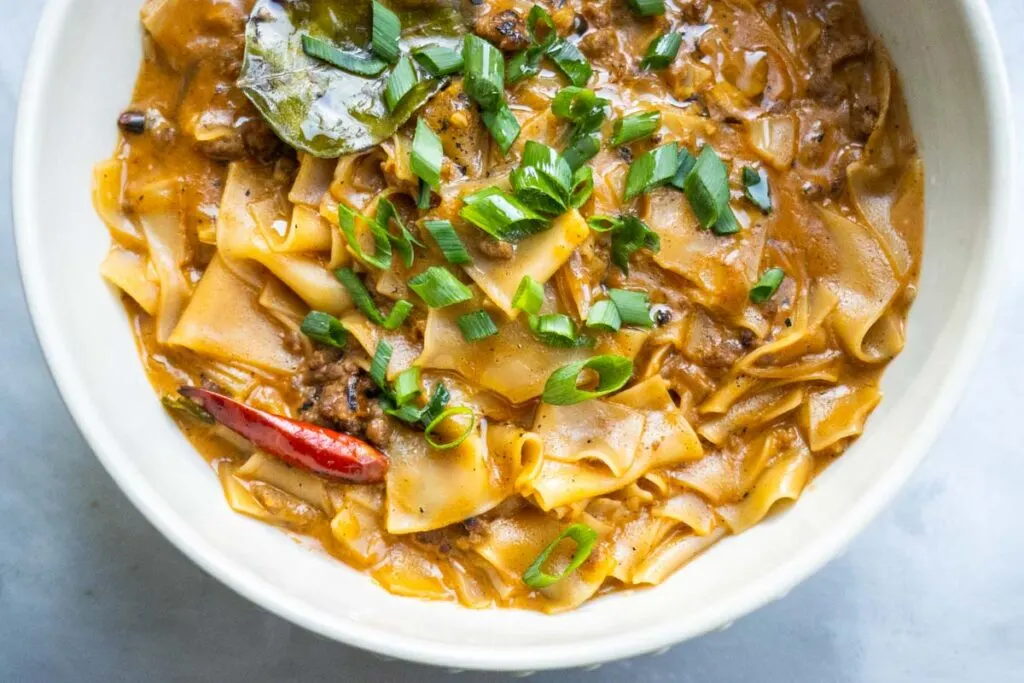
Daryl loves exploring food markets. Whether it’s open air markets in Lyon, salumeria in Bologna or even chain supermarkets in Lisbon, you’ll always find Daryl curiously perusing aisles, looking for new, exotic or outright tasty items to carry home and place on the stove. Drop him in the middle of a foreign market filled with local seafood, cheeses or special fruits and vegetables and it’s almost impossible to pluck him out.
Such is the case with Asian markets.
Once past the usual arrangement of soy sauces, bean pastes and vinegars, he can’t help but make his way toward the Korean aisle with containers of Gochugaru and Gochujang, the Japanese aisle stocked with konbu, mirin and kewpie mayo and the Southeast Asian aisles featuring a range of ingredients from Thailand, Vietnam and elsewhere.

Those Southeast Asian aisles, usually located on the far end of the store, are filled with Thai and Vietnamese specialties like rice noodles, fish sauces, tamarind pastes and an assortment of curries. The pre-made curries are especially intriguing.
Sure, one could slave over a mortar and pestle, like a Thai ‘Auntie,’ grinding heaps of chilies, galangal, shallots and spices into a tasty paste but who has time for that. We find pre-made Thai curries more than acceptable.
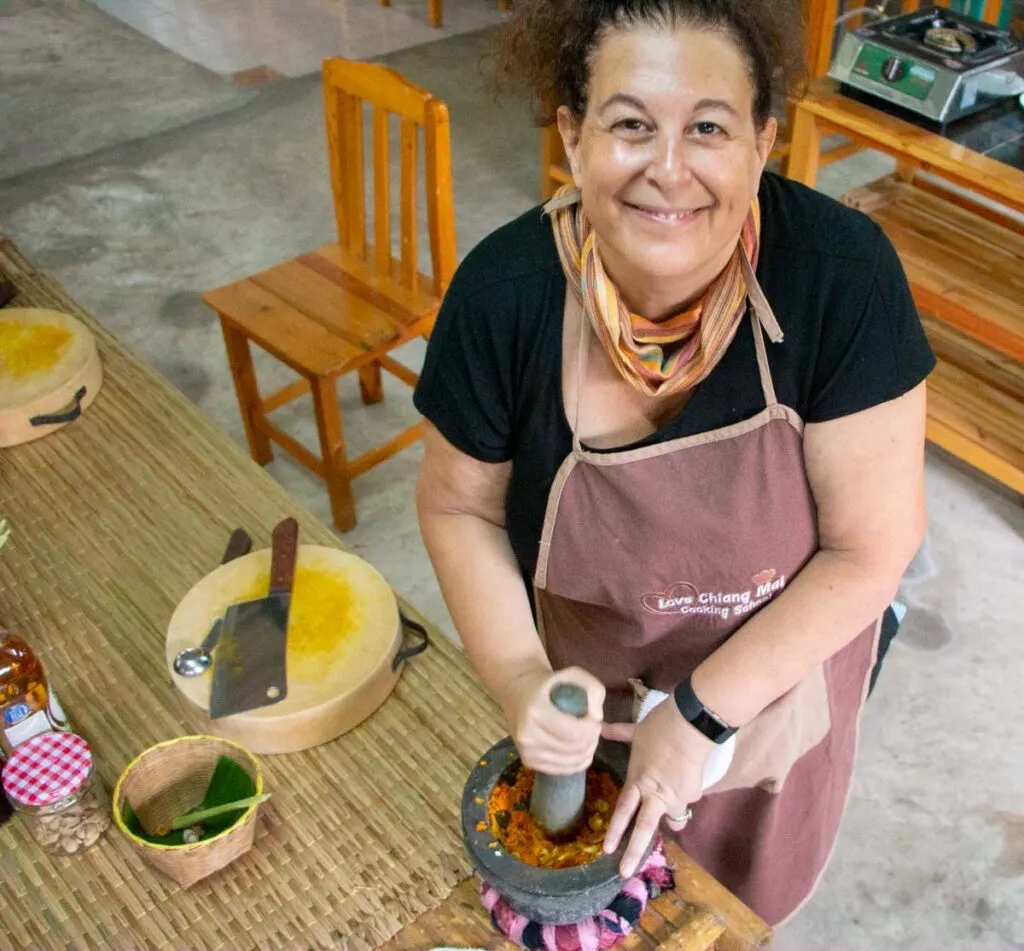
Need a quick lunch? Chop up a little mirepoix, mix in some curry, pour in some coconut milk and you’re all ready to go. You may be a purist and feel a need to make your own curry paste from scratch. We thought the same until we made fresh curry at a Thai cooking class in Chiang Mai.
The class was fun but we quickly learned that making curry paste from scratch is a ton of work that made our arms tired. The pre-made stuff is more than acceptable when we cook our favorite Thai dishes at home.
Discover our favorite Thai dishes.
What Are Thai Noodles with Panang Curry Meat Sauce?
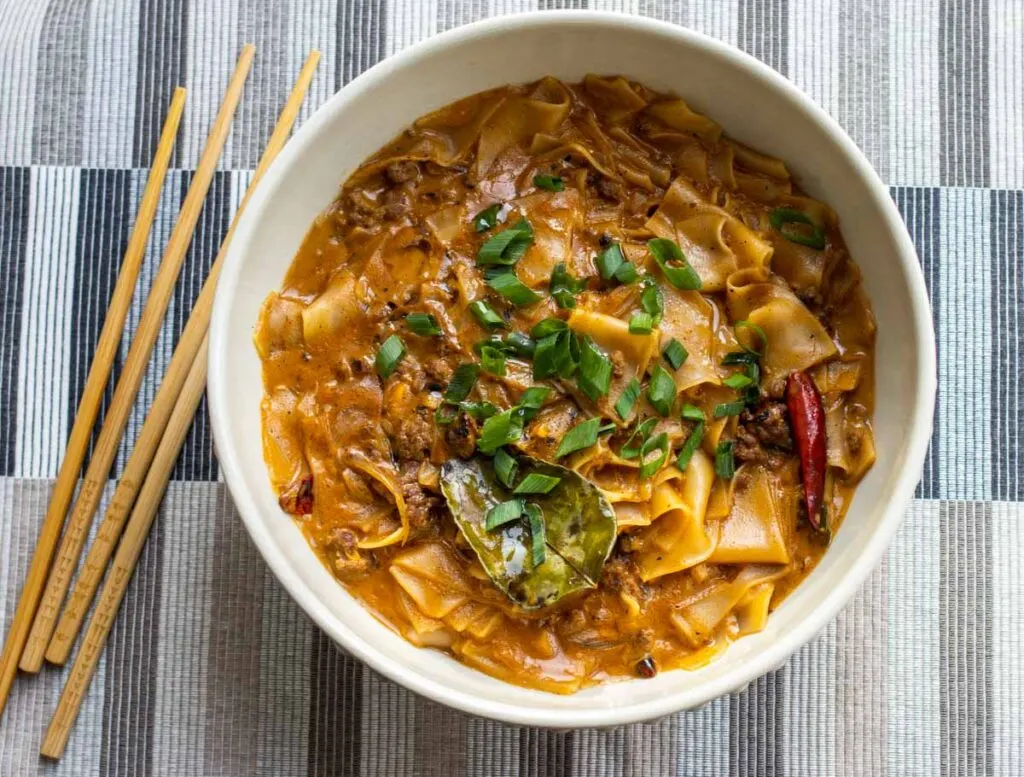
We began our Thai curry journey with Daryl’s favorite – green curry. The green paste, which we use often, tastes great with chicken. However, the green stuff is so popular that it often sells out. That scarcity forced us to discover a range of curries like fiery red and Indian-like yellow. We also discovered panang curry, a rich creamy curry that’s ultra versatile in the kitchen.
To us, the reddish, orange curry is a great companion for ground beef or pork. Mixed with flat rice noodles and coconut milk, the curry tastes uniquely Thai. The pappardelle-like rice noodles carry the sauce brilliantly, creating a wonderful dish that we’ve nicknamed Thai Bolognese.
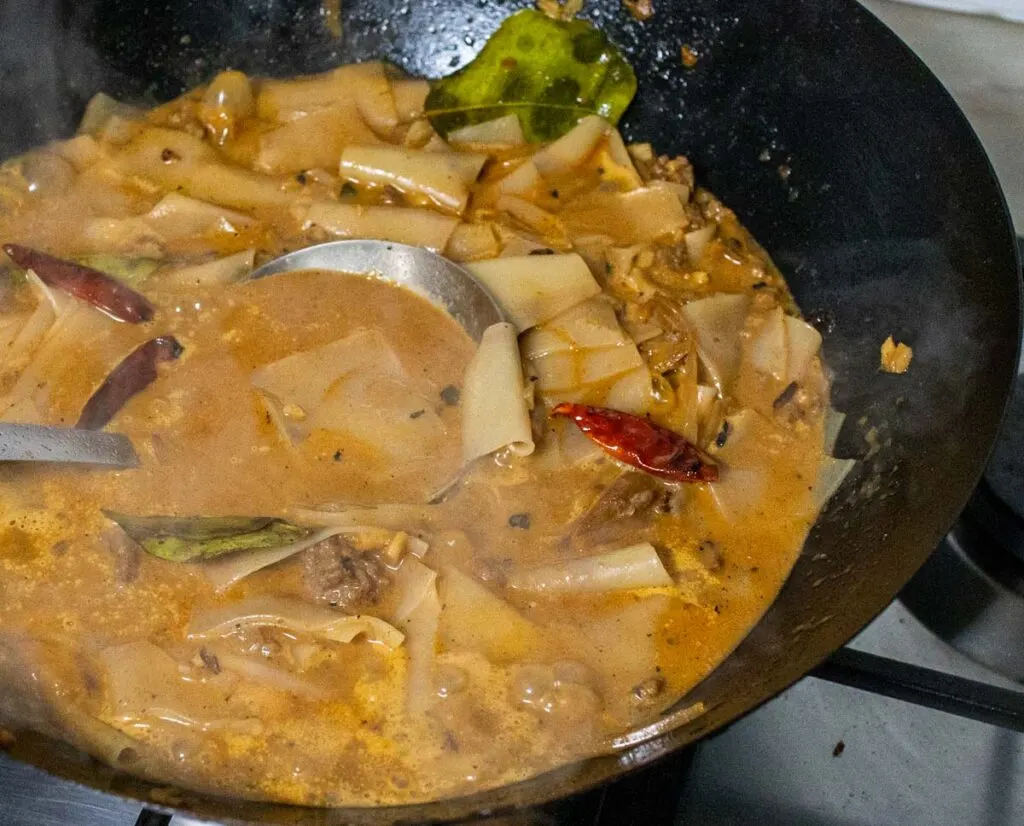
Thai Bolognese satisfies us every time we whip it up. In this dish, rich ground meat provides beefy flavors that meld with the unique caramel sweetness of Thai palm sugar, the sour flavors of makrut (kaffir) lime and the umami undertones of fish sauce to create something special.
The one pot dish is one of our faves and only takes 30 minutes to prepare. Sure, there are a lot of ingredients but it’s super easy to make. Plus, you can even make the dish gluten free by replacing the soy sauces with tamari.
Ingredients
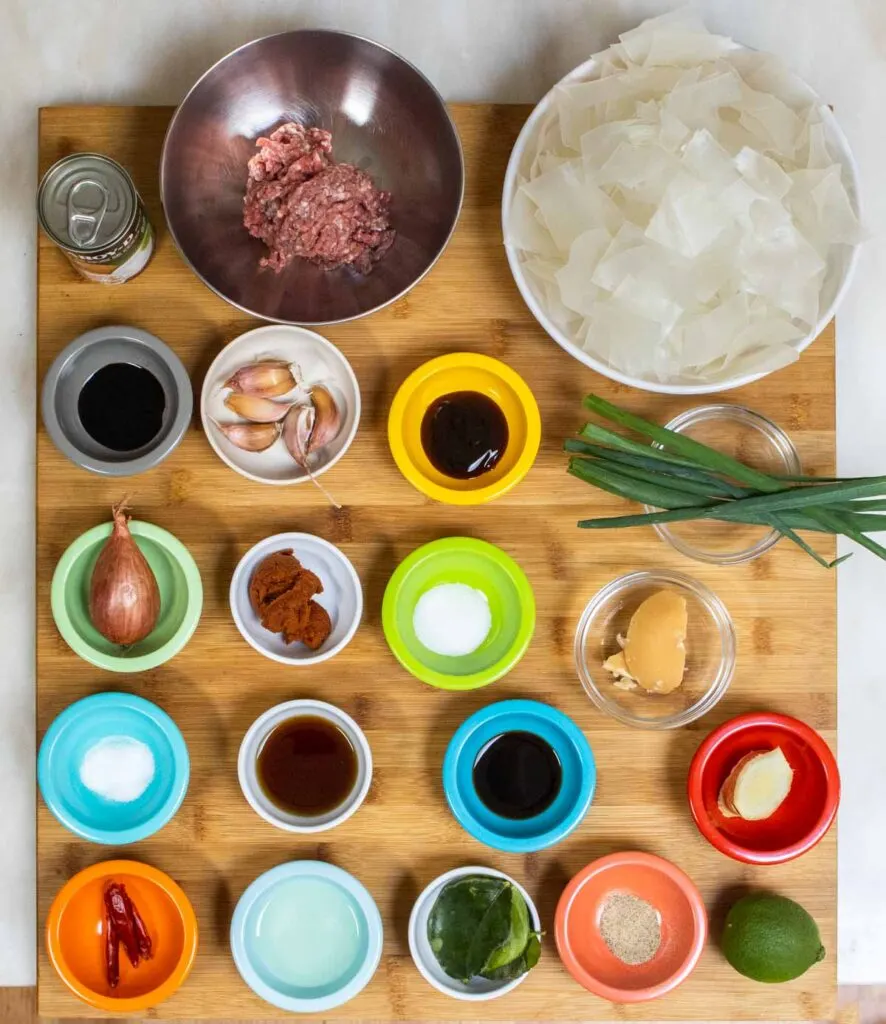
You’ll need the following ingredients for this recipe:
Yes. This recipe calls for a lot of ingredients but don’t be intimidated. Once you assemble a solid Asian Pantry, everything will be at your fingertips. This recipe, like most Asian recipes, calls for a variety of sauces and condiments.
As a bonus, you’ll learn the basics of building Thai flavors when you follow this recipe. Thai cooking is all about the interplay of sweet, sour and spicy.
The only special ingredients you’ll need to source are the panang chili paste, palm sugar and frozen makrut (kaffir) lime leaves. You should be able to find those ingredients at your local Asian market.
Ground Beef Or Pork
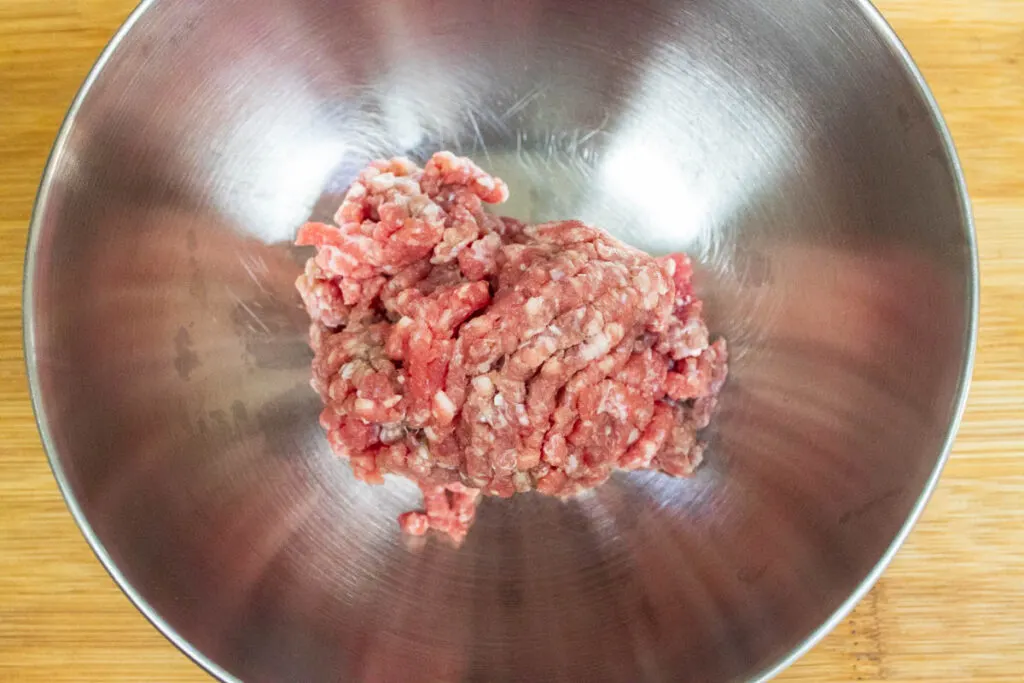
The fun of most Asian recipes is the way cooks can stretch ingredients. In this recipe, we only use a total of 4 ounces of ground beef or pork to feed two people.
We like to marinate the raw meat in a simple combination of soy sauce, fish sauce, salt, pepper and sugar. The sugar facilitates browning in the pan.
Pro Tip
You can use your choice of pork or beef in the recipe.
Panang Curry
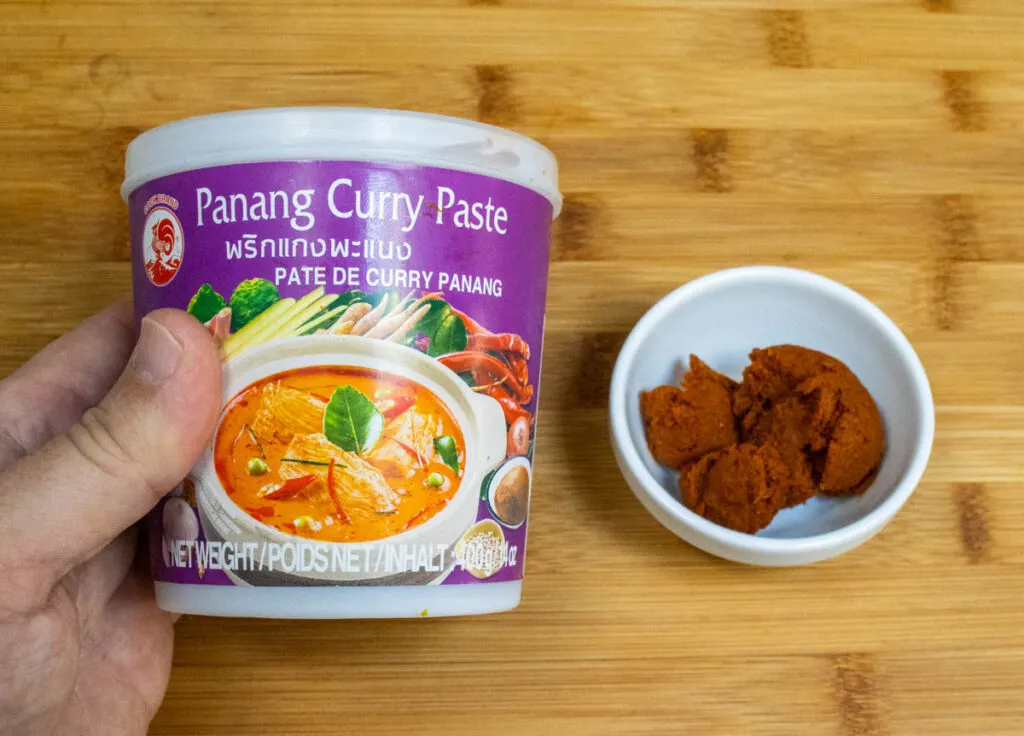
The origins of panang curry are unclear. While it would seem obvious to trace its origins to the Malaysian island of Penang, the roots of the paste skew closer to Central Thailand.
The difference between panang curry and red curry, while slight, are definitive. Unlike red curry, panang curry contains peanuts and makrut (kaffir) lime zest.
Like many Thai chili pastes, panang curry contains spicy red chilies, shrimp paste, lemon grass, galangal, garlic, coriander and white pepper. The addition of peanuts imparts a nutty creaminess while the lime zest imparts acidity.
Pro Tip
You could use red or green curry but your results won’t be quite as creamy and you may have to add additional lime juice during the cooking process in order to create balanced flavors. You can buy panang curry from Amazon if you can’t find it at your local Asian market.
Rice Flake Noodles
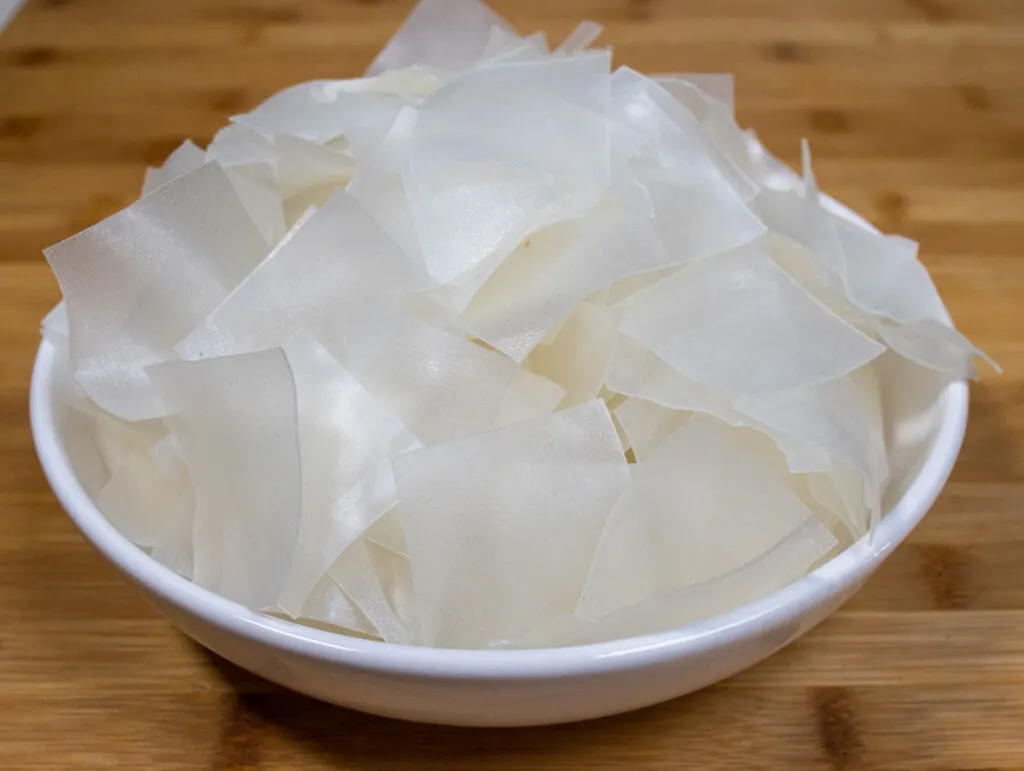
We discovered flat noodle flakes at our local Asian market during our unsuccessful search for fresh rice noodles. They’re wonderful.
After a soak in hot water and high heat cooking, rice flake noodles become a soft and comforting platform for a range of ingredients. They have a texture reminiscent of chow fun noodles and can be used in a variety of recipes including this one.
Pro Tip
You can buy a bag of rice noodle flakes from Amazon if you can’t find them at your local Asian market. Alternatively, you could use wide Asian rice noodles or even a wide wheat pasta, such as pappardelle, fettuccine or tagliatelle as a substitute. If you can buy fresh wide rice noodles where you live, go for it. If you can make your own, even better.
Palm Sugar
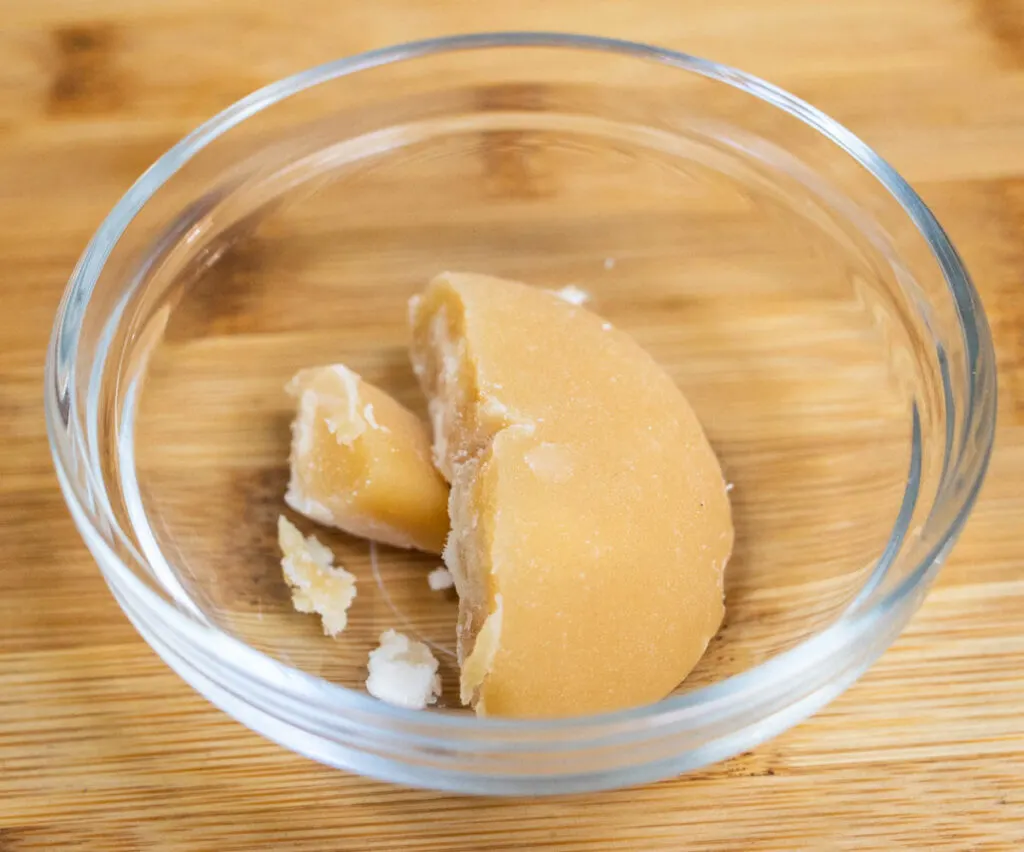
Sweet and sour tropical flavors lie at the heart of Thai cooking. Palm sugar provides much of the sweetness.
Made with palm tree sap, palm sugar has a mellow caramel flavor that’s hard to duplicate. You should be able to find discs of palm sugar at your local Asian market.
Many people will use a mortar and pestle to grind their palm sugar before cooking. However, there’s no need since the palm sugar dissolves while the sauce simmers.
Pro Tip
You can use granulated sugar if you can’t find palm sugar.
Coconut Milk
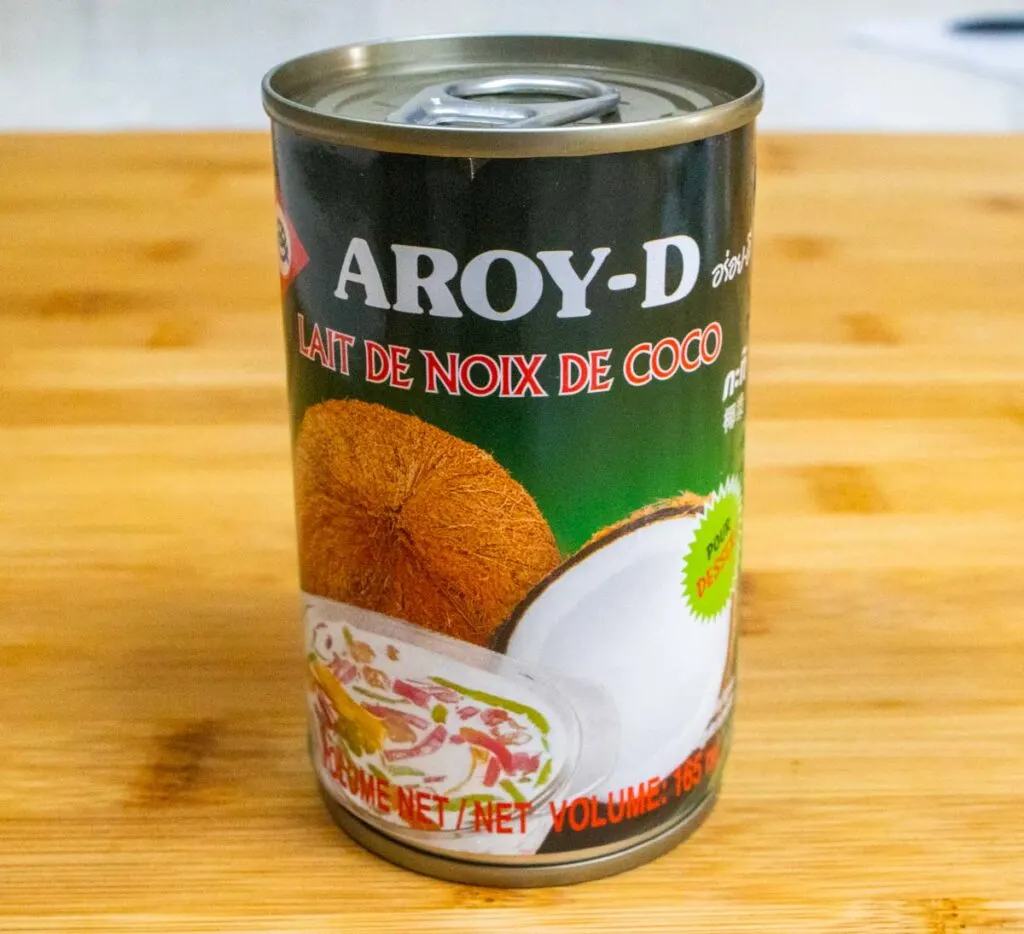
The flavor and creamy texture of coconut milk in Thai recipes is distinct.
We like to buy small cans of whole coconut milk (sometimes called coconut cream) and dilute the milk with water. You can buy coconut milk at your local supermarket but we’ve found the highest quality coconut milks at Asian food markets.
Pro Tip
Always choose coconut cream if you have to choose between that and coconut milk.
Fish Sauce
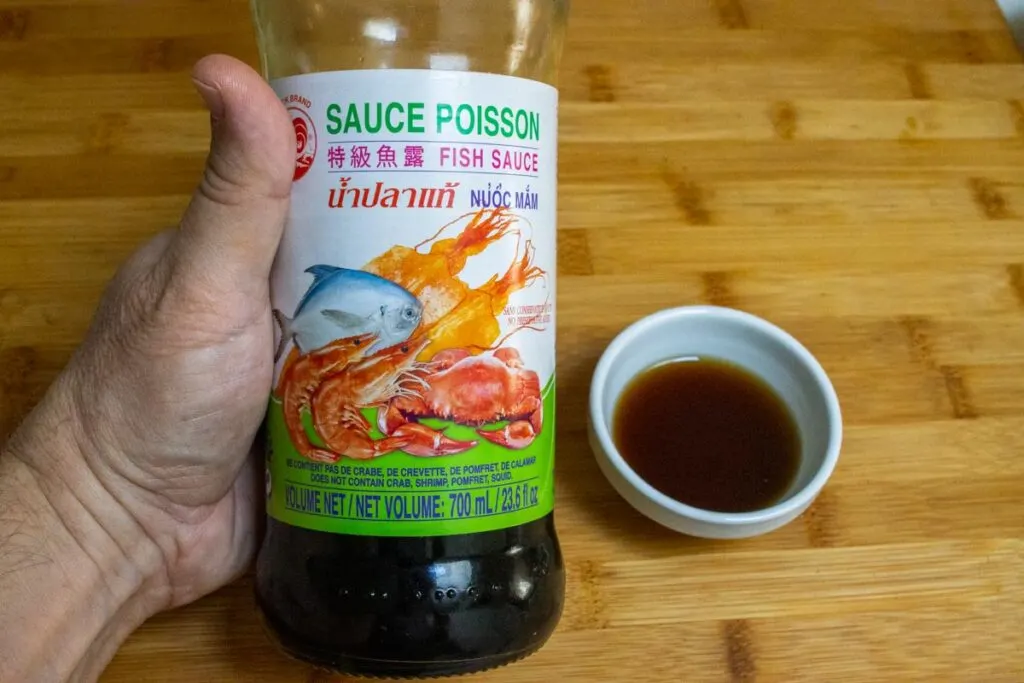
Fish sauce is another unmistakable Asian ingredient that doubles as both a seasoning agent (it’s super salty) and umami enhancer. When used correctly, the condiment provides backbone to the dish.
We use fish sauce both in the marinade and in the cooking process. You should be able to find good Thai or Vietnamese fish sauces at most Asian markets. Chefs love the brand with the three crabs on the label but any brand will work in this recipe.
Makrut (Kaffir) Lime Leaves
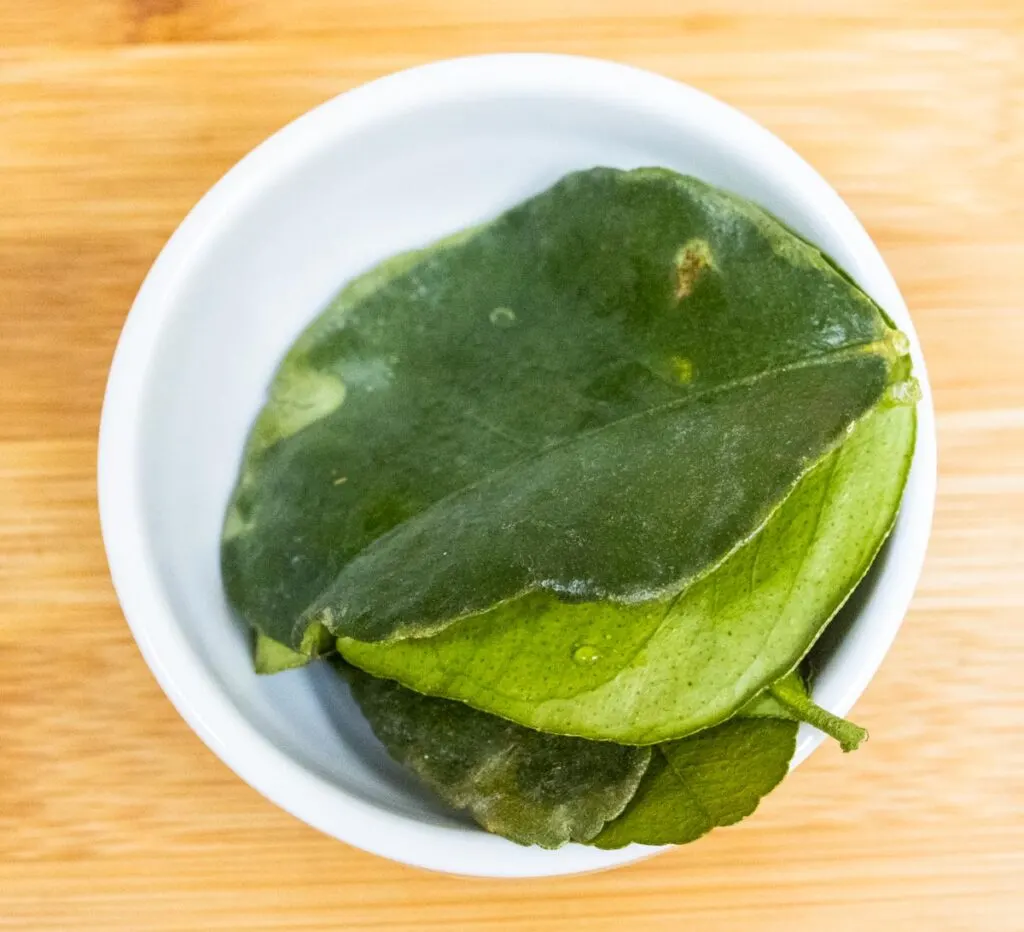
While Panang curry may contain makrut (kaffir) lime zest, makrut lime leaves provide an extra dose of flavor and fragrance to the dish. We like to add them whole similar to how we add bay leaves to a stew.
Pro Tip
You may want to remove the leaves before serving since they’re inedible in their whole leaf form.
Dry Chilies
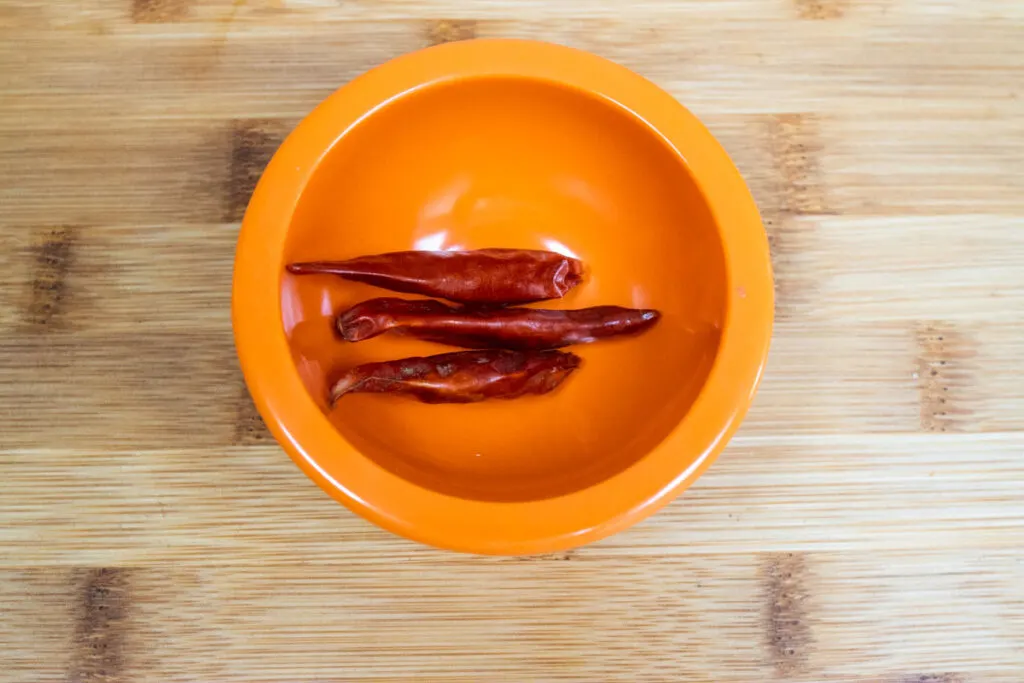
We like to add dry chilies to provide extra heat in the recipe. We add them whole and, like the lime leaves, they can be discarded before serving.
Pro Tip
You can use either Chinese or Thai dried chilies.
Mirepoix – Ginger, Garlic And Shallots
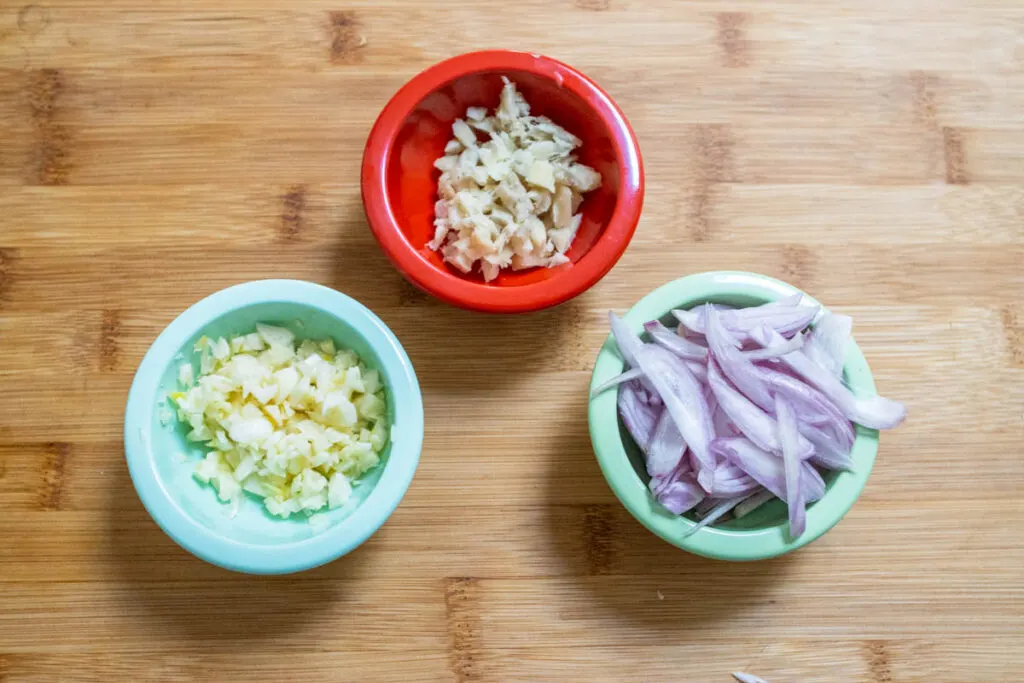
You’ll commonly find garlic and shallots in the mirepoix of most Thai recipes along with galangal and krachai, a Southeast Asian form of ginger. We can easily find both frozen galangal and fresh ginger at our local Asian markets. Given the choice, we prefer to use fresh ginger over frozen galangal.
The Thai use tiny Thai shallots in their recipes but any thinly sliced shallot will work. One last note: The Thai use a lot of garlic and we do the same.
Common Asian Condiments – Dark Soy Sauce, Light Soy Sauces and Oyster Sauce
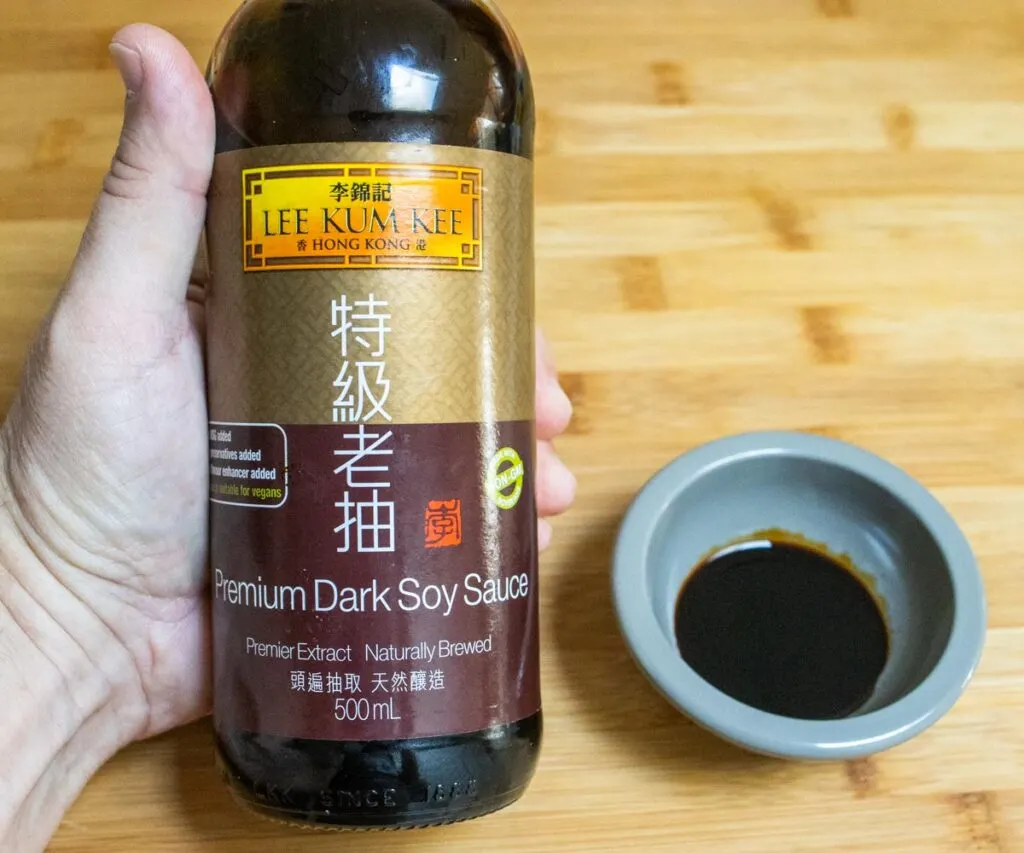
The influence of the Chinese in Thai cooking is strong and shows up in this recipe in the form of light and dark Chinese soy sauces and Chinese oyster sauce.
Special Thai versions of all three sauces are available but we choose to use the Chinese sauces since they’re something we always have in our pantry.
Fresh Lime Juice
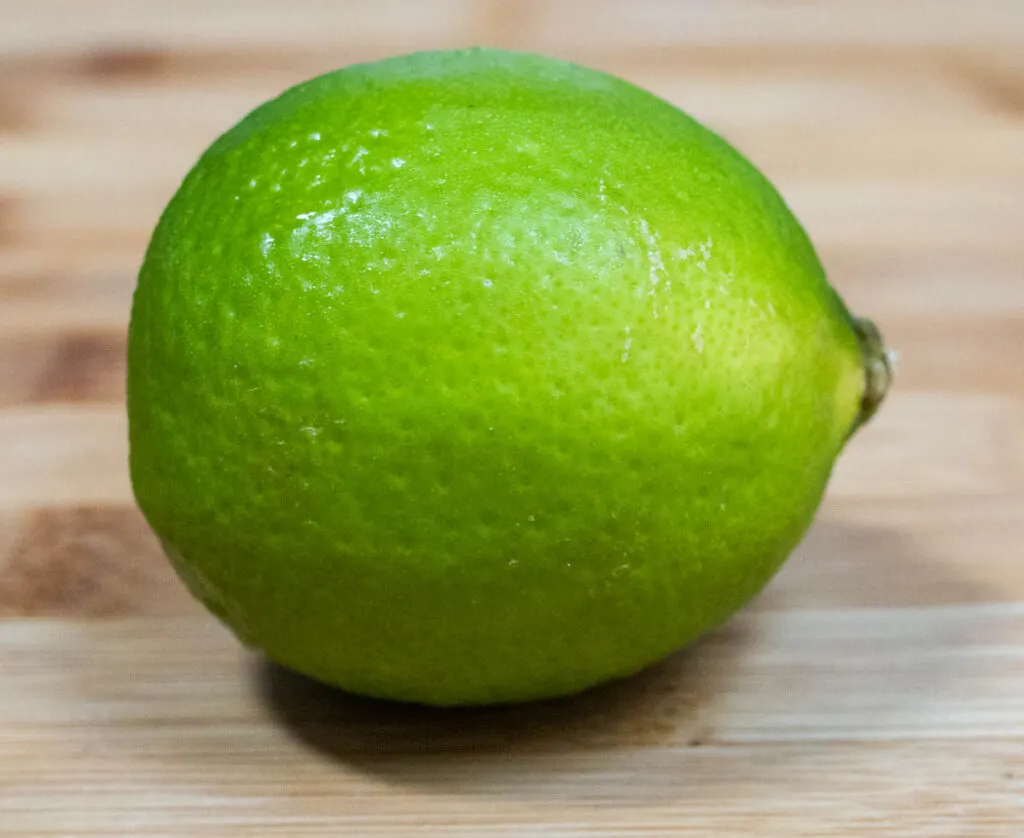
We’ll occasionally squeeze some lime in the pan while cooking this dish if our sauce begins to taste too sweet.
We generally don’t have to do this step due to the Panang Curry’s natural acidity. However, we always squeeze a little lime juice on the finished dish to add brightness.
How to Make Thai Panang Curry Noodles with Meat Sauce
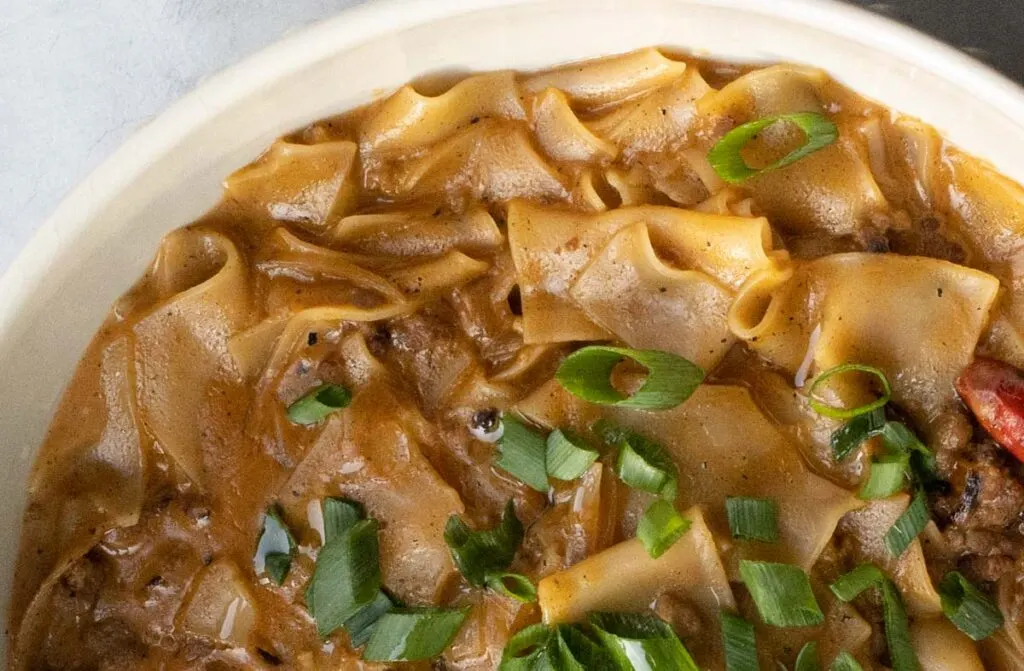
The first step is to organize the mise en place before cooking. It’s important to have all of the ingredients at the ready since the process of cooking this dish moves fast.
30 minutes before cooking, soak the noodles in hot water from the sink. Do no use boiling water. The temperature should be around 135°F/57°C.
The noodles should be pliable (bendable) before entering the pot.
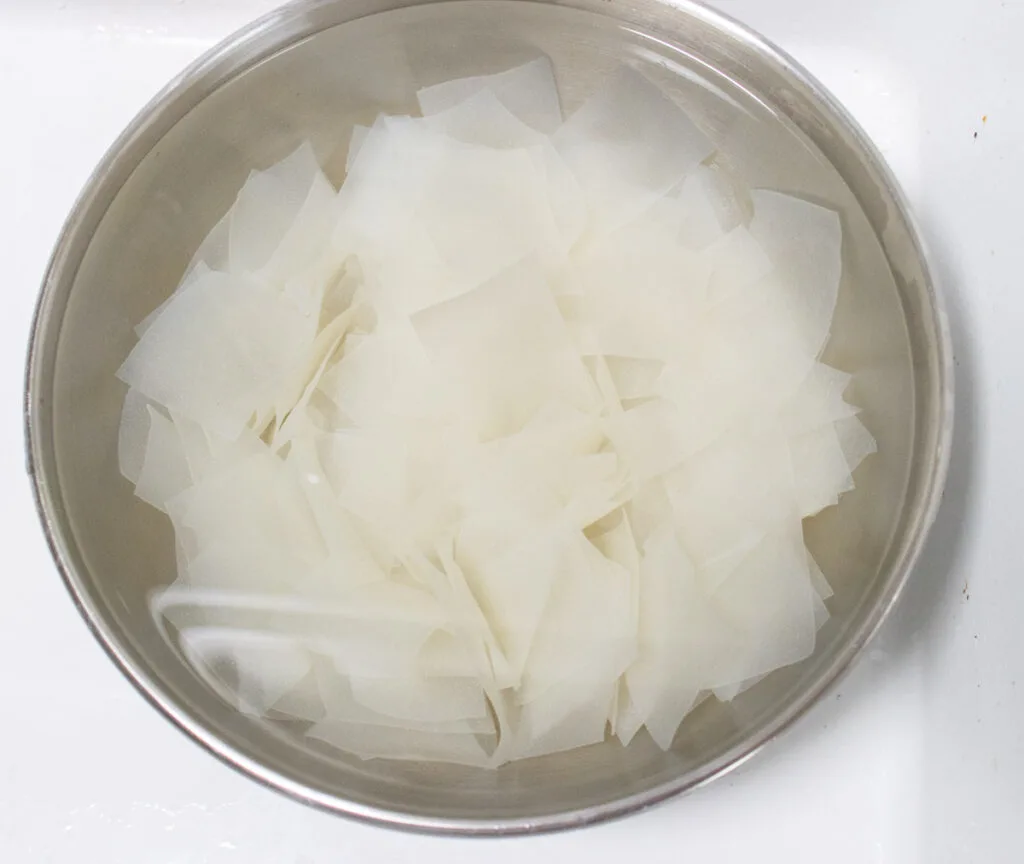
Start by marinating your ground meat with the fish sauce, soy sauce, oyster sauce, granulated sugar, salt and pepper.
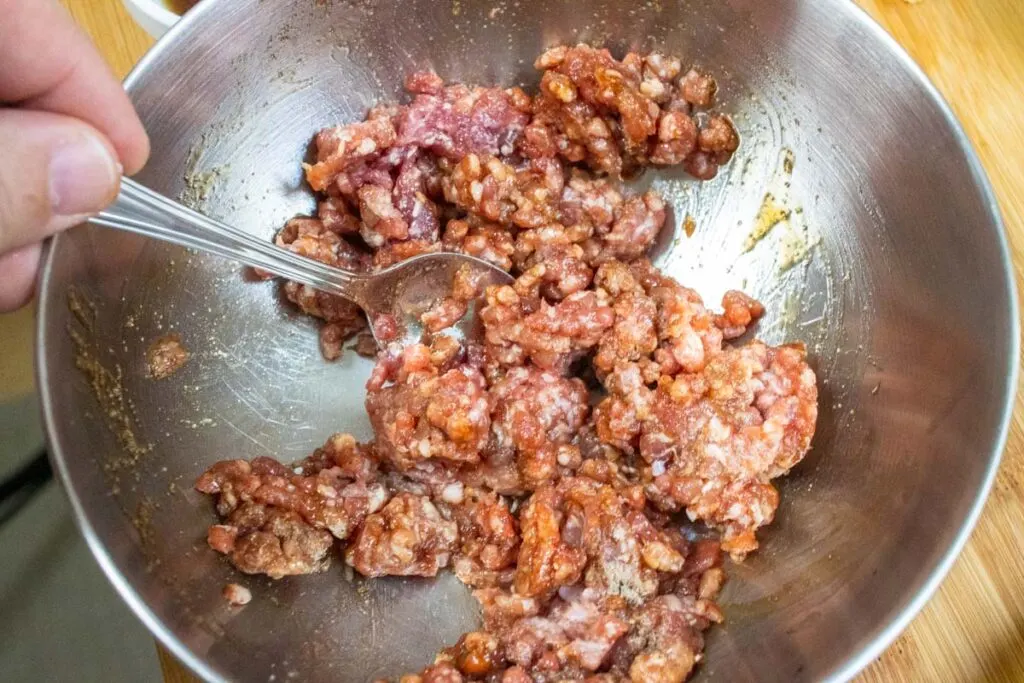
We like to cook the dish in our carbon steel wok. You can also use a 12” nonstick frying pan if you don’t have a wok.
Begin by heating the wok or pan, removing it from the heat and coating it with a little of the oil.
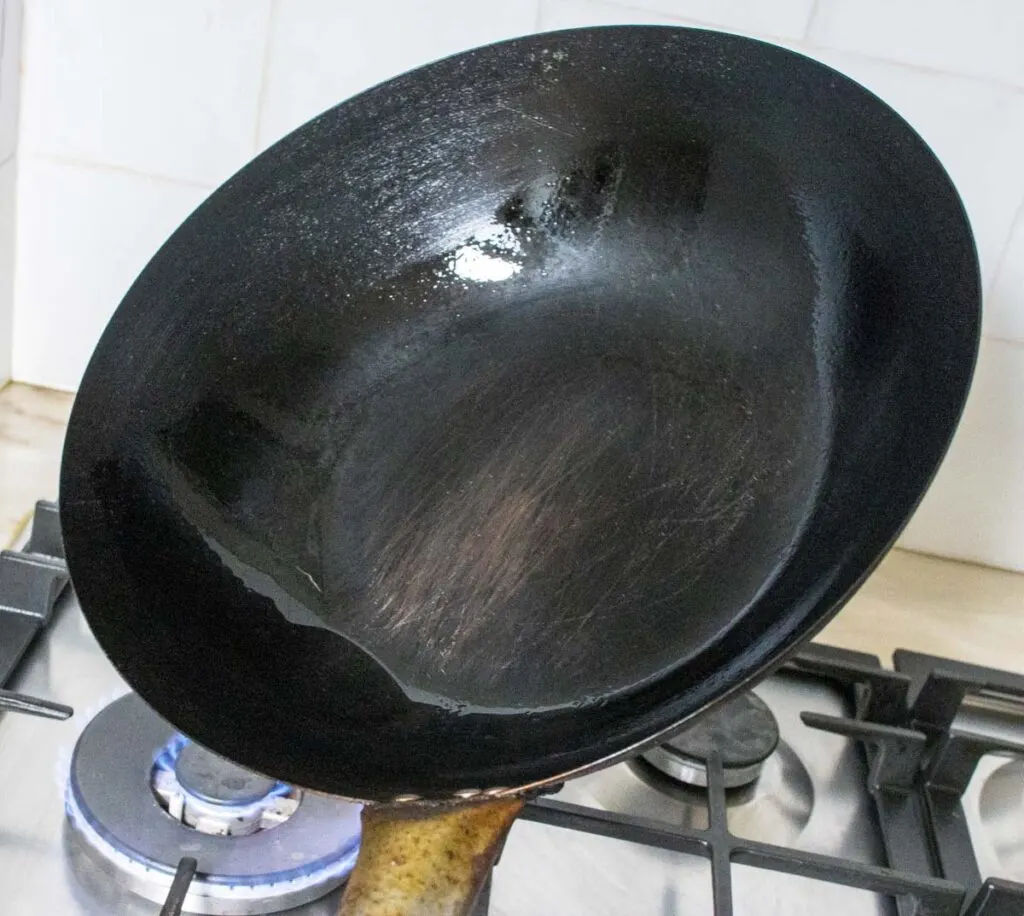
Pour the rest of the oil in the pan. Once the oil is smoking, add the ground meat to the hot pan. Cook the meat until it just turns brown. You won’t need to remove the meat from the pan.
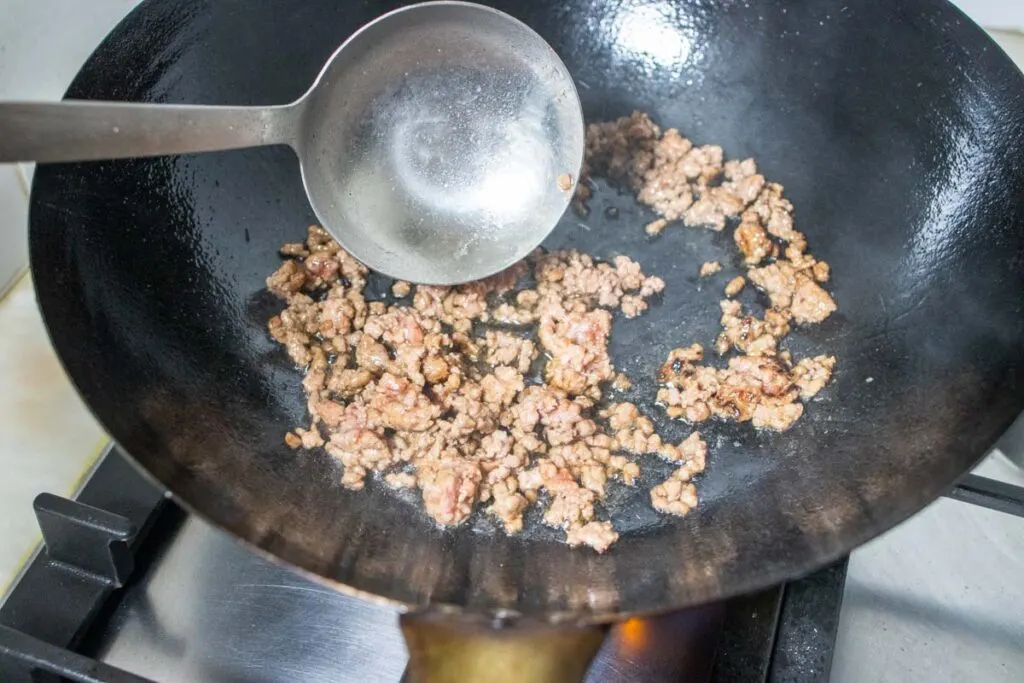
Add the shallots, garlic and ginger to the pan and cook until soft.
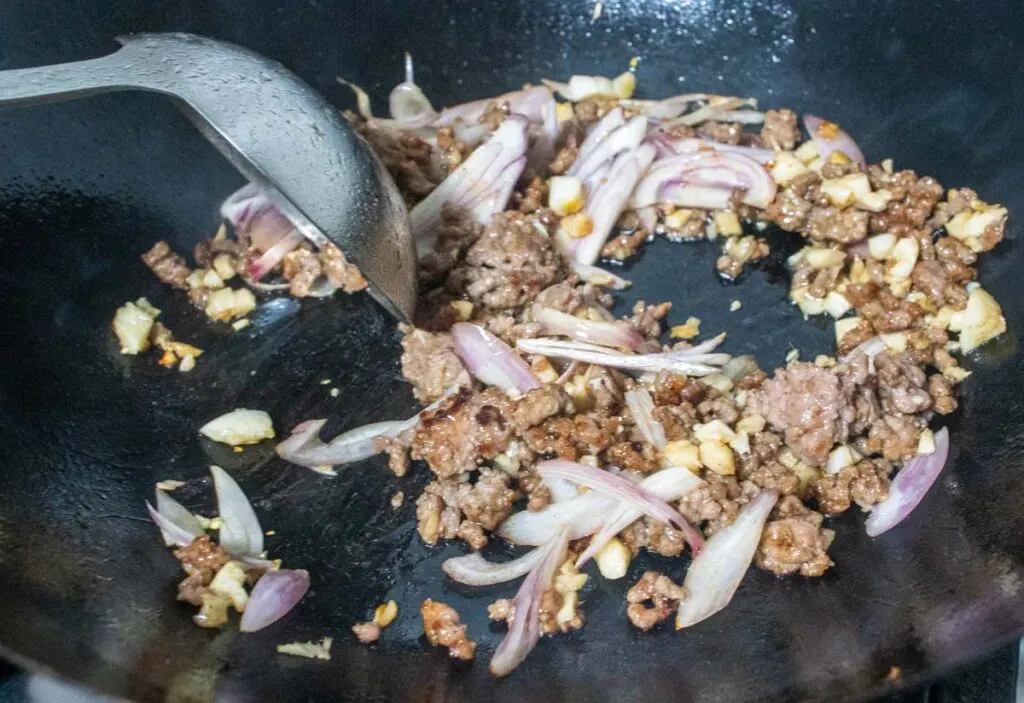
Next add the panang curry, dried chilies and makrut (kaffir) leaves to the pan and cook until fragrant.
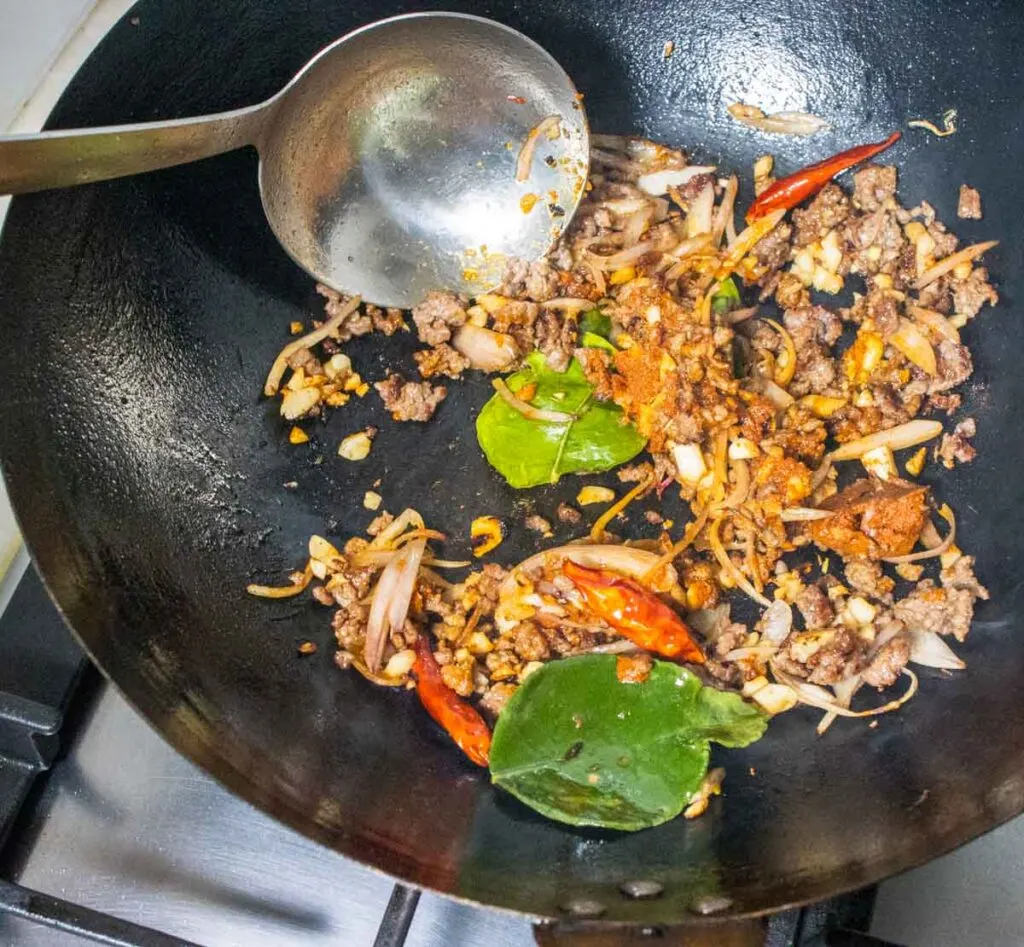
Add the remainder of the fish sauce, soy sauce, oyster sauce, a pinch of salt and white pepper to taste.
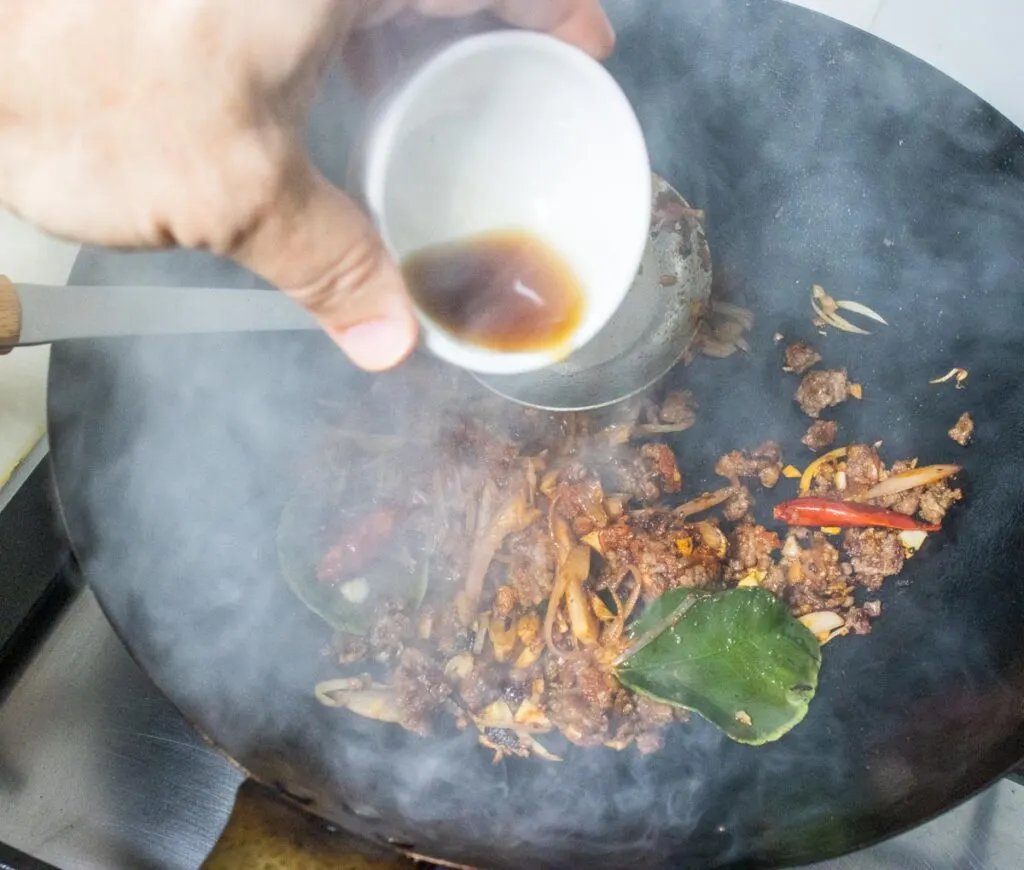
Add the palm sugar after all of the sauces are thoroughly mixed.
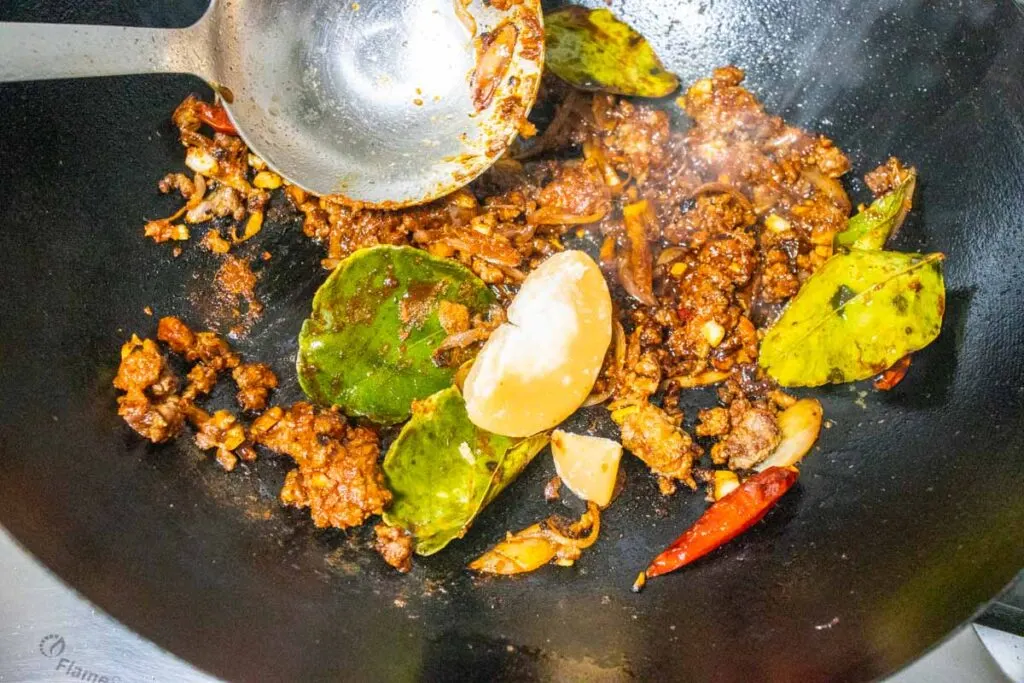
Once the palm sugar is added, immediately add the coconut milk along with an additional cup of water.
Pro Tip
You can fill the can with the extra water to get the extra bits of coconut milk stuck to the sides of the can into the pot.
Cook the curry mixture until the coconut milk and curry are well incorporated and the the mixture reaches a steady simmer.
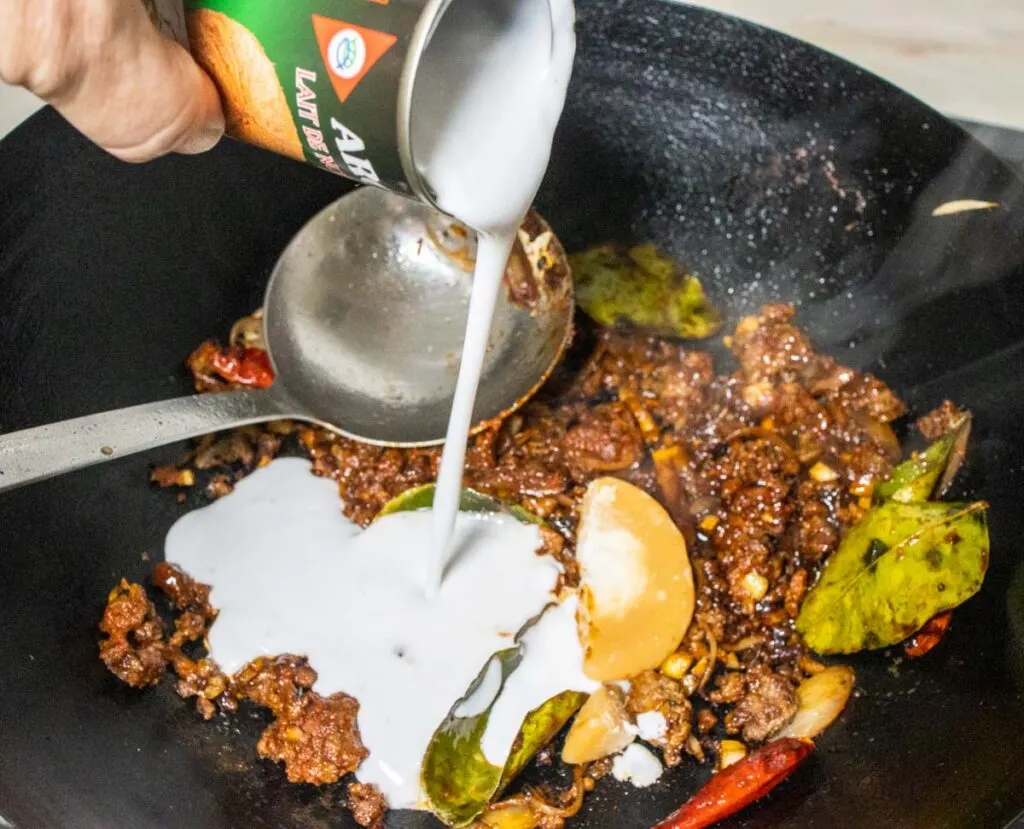
Drain much of the water from the noodles by using you hand to drain off the liquid. Don’t worry about draining all of the liquid.
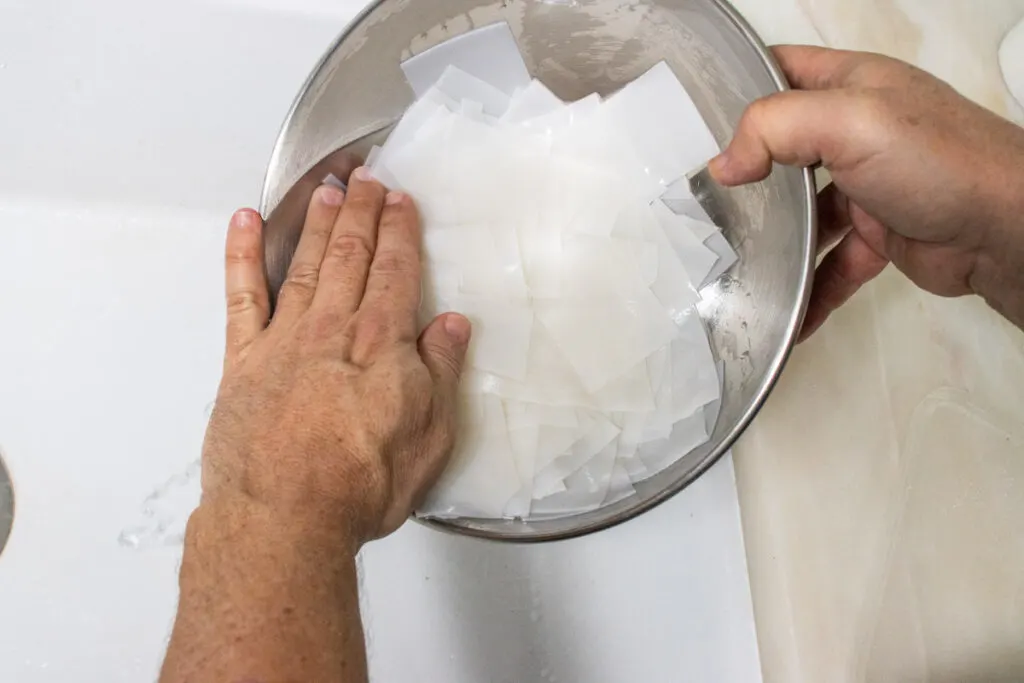
Drop the noodles into the sauce and stir.
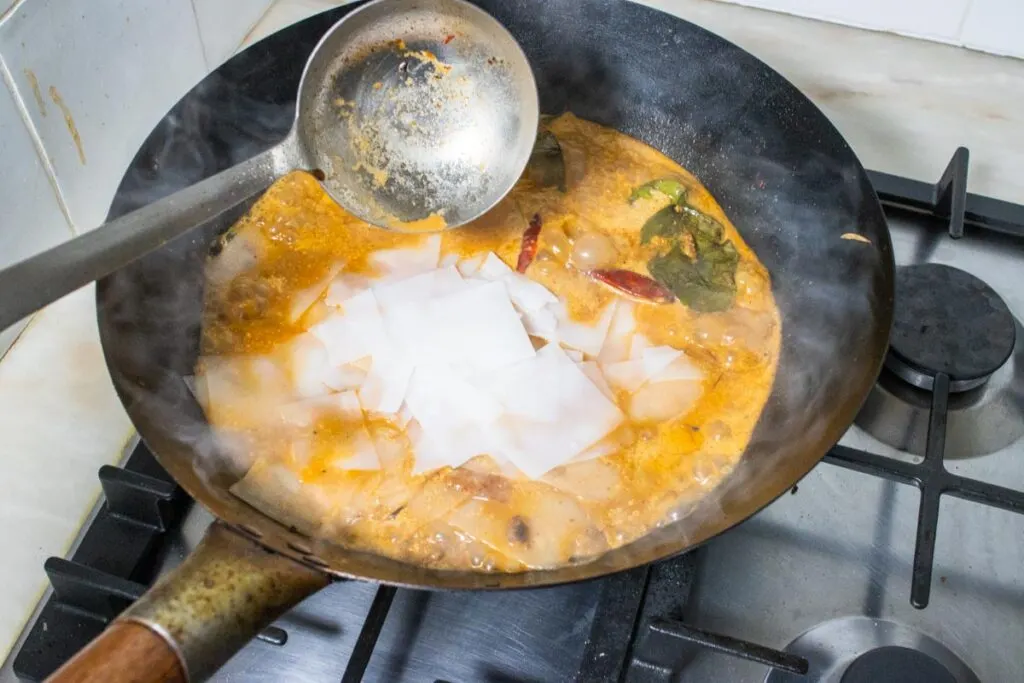
Cook at a steady simmer about 7 minutes or until the noodles are soft and the sauce is thick. Add extra water if the mixture becomes too thick or if the noodles begin to stick to the bottom of the pan.
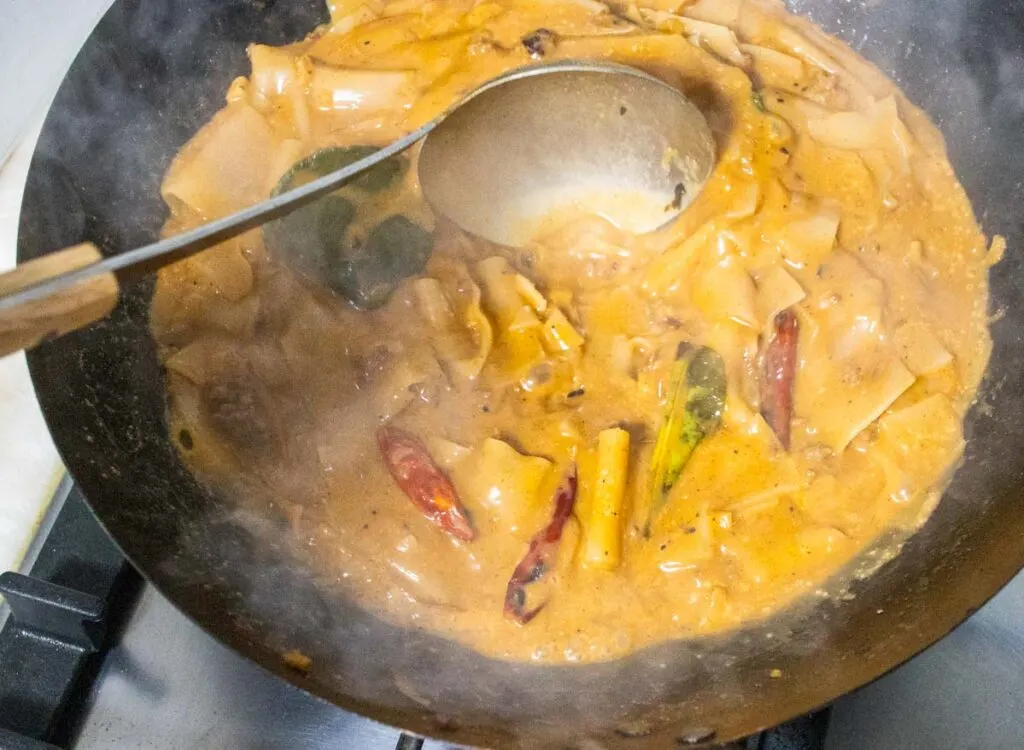
Once the noodles are soft, transfer the mixture to a large bowl and garnish with scallion greens.
Serve in individual bowls with lime wedges.
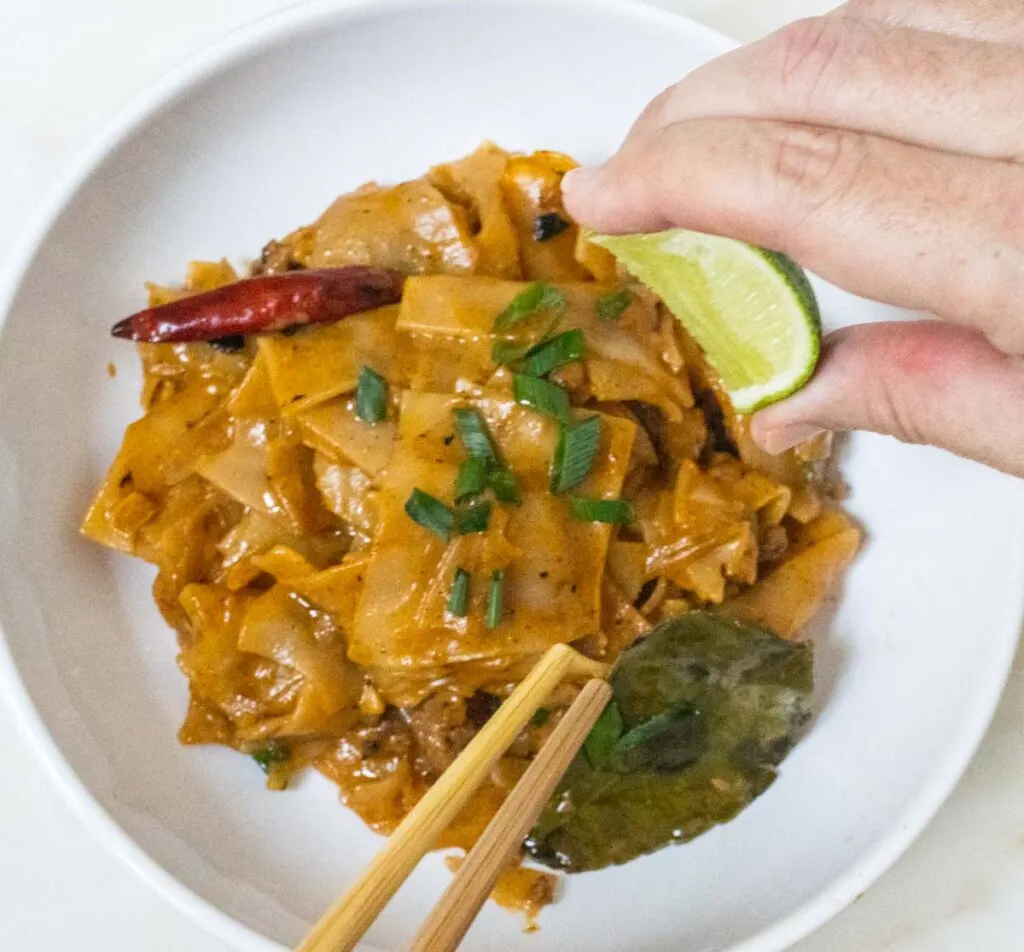
As an option, you can also garnish with cilantro leaves.
Did you make this recipe? If so, please rate it below.
Thai Panang Curry Noodles with Meat Sauce Recipe
Ingredients
- 1½ tablespoons panang curry
- 4 ounces ground beef
- 8 ounces rice noodles
- 5 makrut (kaffir lime leaves, frozen)
- 1 ounce palm sugar
- 1 medium shallot (finely sliced)
- 5 garlic cloves (minced)
- 20 grams ginger (coarsely minced)
- 5.6 fluid ounces coconut milk (small can)
- 1 teaspoon sugar (for meat marinade)
- 2 tablespoons fish sauce
- 3 dried Thai chilies
- 1½ teaspoons light soy sauce
- 1 teaspoon dark soy sauce
- 1 tablespoon oyster sauce
- 1 tablespoon vegetable oil
- 1 cup water
- salt (to taste)
- white pepper (to taste)
- scallion (green part only for garnish, thinly sliced)
Equipment
Instructions
- Soak rice noodles in a bowl of hot tap water to soften for 30 minutes
- Meanwhile, marinate the ground beef in 1/2 teaspoon of the light soy sauce, 1/4 teaspoon of the dark soy sauce, 1/2 teaspoon of the fish sauce, a teaspoon of sugar and a dash of salt and white pepper.
- After the noodles have soaked for 20 minutes, preheat carbon steel wok until smoking and coat with a small amount of the oil. Remove from heat and turn the fire to medium.
- Place the wok back over the flame and add the rest of the oil. Once the oil is shimmering, add the ground beef and cook until just brown.
- After the meat has browned, add the shallots, garlic and ginger. Cook until soft, about two minutes.
- After the mirepoix has softened, add the panang curry, the dried chilies and the makrut (kafir) lime leaves. Cook until fragrant, about two minutes.
- Add the remainder of the fish sauce, light soy sauce, dark soy sauce and oyster sauce. Cook for about one minute.
- Add the palm sugar.
- Immediately after adding the palm sugar, add the coconut milk and 1 cup of water. Bring the mixture to a steady simmer.
- Drain the noodles in the sink by tilting the water from the bowl. You don't have to entirely drain the noodles.
- Add the noodles to the pot, along with the small amount of remaining liquid, and cook the mixture until the noodles are soft. Add more water if the mixture becomes too thick and the noodles begin to stick to the bottom of the pan.
- The dish is done when the noodles are soft and the sauce reaches a thick yet viscous consistency.
- Transfer the finished noodles to a serving bowl, garnish with thinly sliced scallion greens and serve with a lime wedge.
Pro Tips
- The recipe can be doubled for four people.
- You can use a 12 inch non-stick pan if you don't have a wok.
- You can substitute ground pork for the ground beef.
- You can alternatively garnish the dish with cilantro leaves, lime zest, roasted peanuts or all three.
Estimated Nutrition

About the Authors
Daryl and Mindi Hirsch
Saveur Magazine’s BEST TRAVEL BLOG award winners Daryl and Mindi Hirsch share their culinary travel experiences and recipes on the 2foodtrippers website. Since launching the site in 2012, they’ve traveled to over 40 countries in their quest to bring readers a unique taste of the world.
Original Publication Date: December 27, 2021

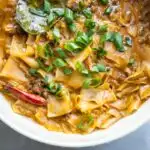
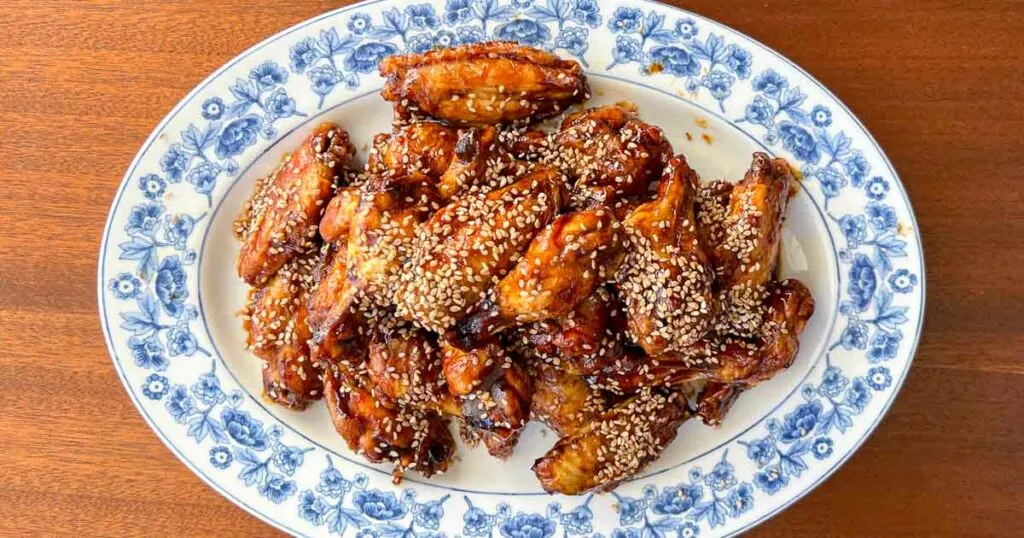
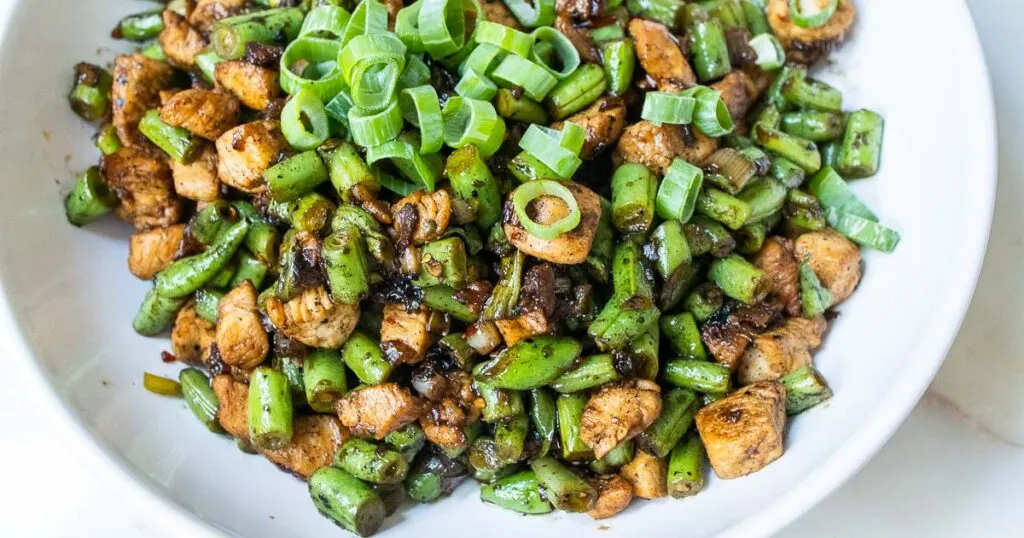
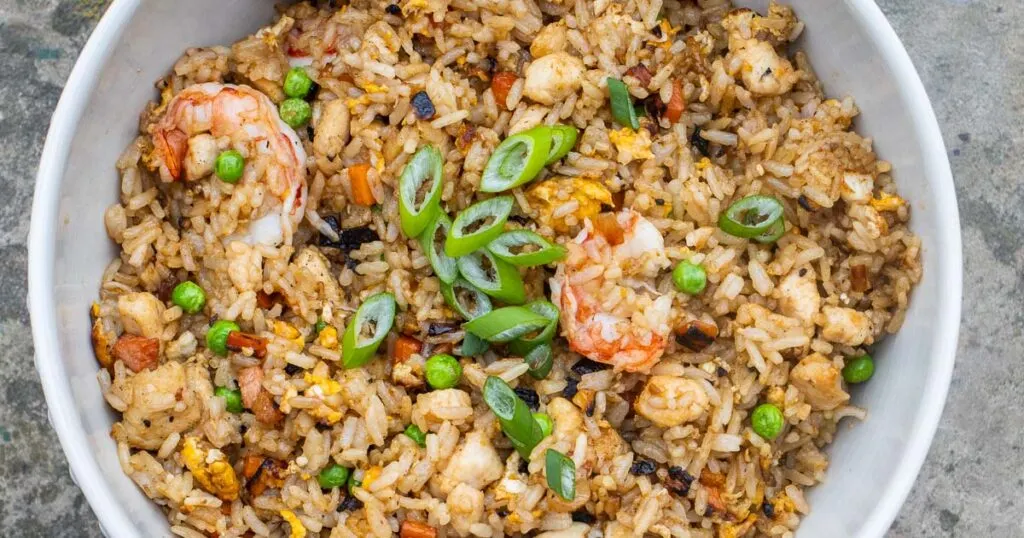
Tom
Tuesday 28th of December 2021
As a thai person, actually having a beef Panang for dinner tonight, this noodle Panang is quite unusual. It’s not what we eat in Thailand. We typically eat Panang with rice. Eating Panang with noodle is like eating pasta with pizza sauce. Doable but not really.
Daryl and Mindi Hirsch
Sunday 30th of January 2022
We suggest you try the recipe. In the culinary world, we find that, as long certain traditions aren't totally ignored (we did use ingredients like fish sauce, palm sugar, and kaffir/makrut lime leaves) rules are meant to be broken. It's a great tasting dish. If you stand on those "traditions" you may be missing out.